Glass Fiber Market Outlook - 2032
The global glass fiber market size was valued at $20.9 billion in 2022, and is projected to reach $34.8 billion by 2032, growing at a CAGR of 5.3% from 2023 to 2032.
Report Key Highlighters:
- The glass fiber market is fragmented in nature with few players such as Honeywell International Inc., Nippon Electric Glass Co., Ltd., TAIWAN GLASS IND. CORP., SGL Carbon, Mitsubishi Chemical Group Corporation, Owens Corning, 3B The Fibreglass Company, Johns Manville, Montex Glass Fibre Industries Pvt. Ltd., and China Jushi Co., Ltd., which hold a significant share of the market.
- The report provides complete analysis of the market status across key regions and more than 15 countries across the globe in terms of value ($ Million) and volume (Kiloton)
- Top winning strategies are analyzed by performing a thorough study of the leading players in the glass fiber market. Comprehensive analysis of recent developments and growth curves of various companies helps us to understand the growth strategies adopted by them and their potential effect on the market.
- The report provides competitive dynamics by evaluating business segments, product portfolios, target market revenue, geographical presence and key strategic developments by prominent manufacturers.
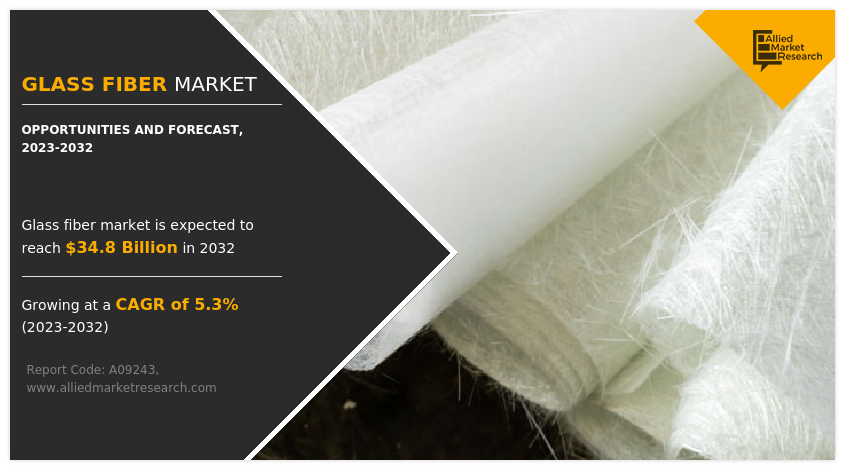
Glass fiber, also known as fiberglass, is a material made from extremely fine fibers of glass. These fibers can be woven into a mat or cloth and then impregnated with a resin to create a strong and lightweight composite material. Glass fibers are known for their high strength, low weight, and resistance to heat and corrosion.
The construction industry is a significant consumer of glass fibers, particularly for reinforcing concrete. The demand for glass fibers in construction materials may also grow as construction activities and infrastructure projects increase globally.
The automotive and aerospace sectors often use glass fiber composites to reduce weight while maintaining strength. The demand for glass fibers could see growth with a continued focus on lightweight materials in these industries for fuel efficiency and performance.
However, glass fibers themselves are resistant to corrosion, the metal components used in conjunction with glass fiber composites, such as fasteners or structural supports, may be susceptible to corrosion. The process can be complex and may not be as straightforward as recycling other materials while glass fibers are recyclable. The recycling infrastructure for composite materials, including those containing glass fibers, has been still evolving. These factors are anticipated to offer remunerative opportunities for the glass fiber market during the forecast period.
The glass fiber market is segmented on the basis of glass type, application, end -use industry, and region. On the basis of type, the market is categorized into S glass fiber, C glass fiber, E/ECR glass fiber, and others. On the basis of application, it is segregated into insulation, filtration media, reinforcements, optical fibers, and others. On the basis of end-use industry, it is segregated into aerospace, transportation, building and construction, electrical and electronics, and others. On the basis of region, the market is studied across North America, Europe, Asia-Pacific, and LAMEA.
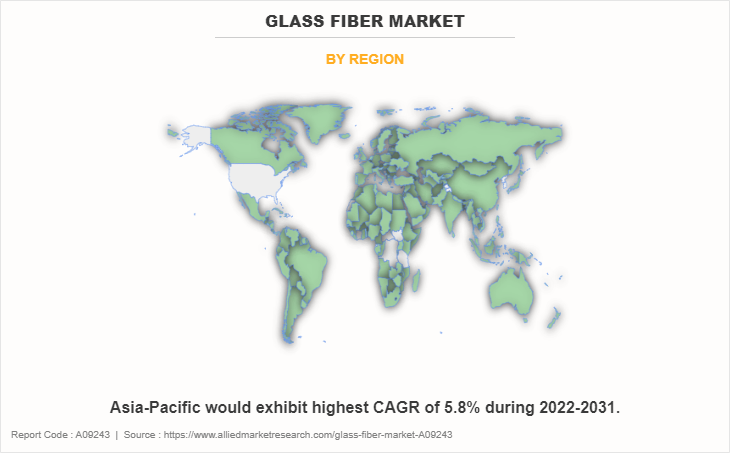
Glass Fiber Market By Region
The glass fiber market size is projected to grow at the highest CAGR during the forecast period and accounted for more than half of glass fiber market share in 2022. Government initiatives promoting infrastructure development, manufacturing, and sustainability contribute to the increased use of glass fiber in various applications. Japan has a strong presence in both the automotive and aerospace industries.
Glass fiber is used in the manufacturing of lightweight components for vehicles and aircraft. Similar to other Asian countries, South Korea experiences ongoing construction and infrastructure projects, and glass fiber is utilized in various construction applications.
South Korean companies are globally competitive in industries such as automotive, electronics, and manufacturing, influencing the demand for materials like glass fiber. These factors have created lucrative opportunities for the glass fiber in the Asia-Pacific ion during the upcoming periods.
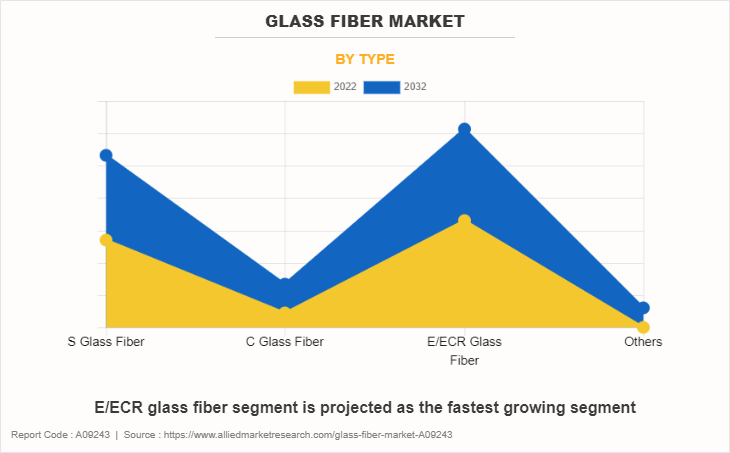
Glass Fiber Market By Type
On the basis of type, the E/ECR glass fiber segment dominated the global market in 2022 and is anticipated to grow at a highest CAGR during the forecast period. Flame retardants are essential to meet safety codes in construction materials. In the automotive sector, flame retardants are used in components such as wiring harnesses, gaskets, and interior materials to reduce the risk of fires.
The continued growth of the automotive industry globally contributes to the demand for flame-retardant rubber materials. Flame retardants are essential in the electronics and electrical sectors to enhance the fire safety of cables, connectors, and insulation materials, particularly in consumer electronics and industrial equipment.
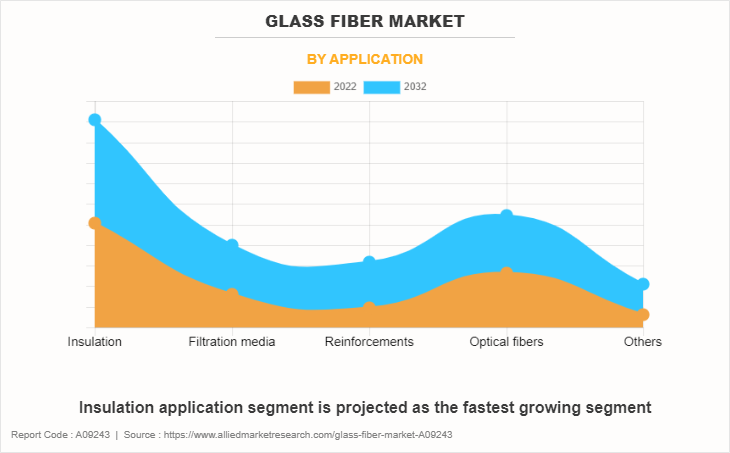
Glass Fiber Market By Application
In 2022, the insulation segment was the largest revenue generator, and is anticipated to grow at a CAGR of more than 5.0% during the forecast period. The construction of renewable energy facilities, such as wind farms and solar installations, often requires insulation materials. Glass fiber-reinforced insulation is utilized in wind turbine nacelles and other components to enhance thermal and acoustic properties.
Industries that require thermal insulation in their processes, such as petrochemical, manufacturing, and power generation, contribute to the demand for glass fiber insulation.
Glass fibers provide effective insulation in high-temperature environments. Heating, ventilation, and air conditioning (HVAC) systems often incorporate glass fiber insulation to improve energy efficiency and maintain temperature control. The growth of HVAC installations in residential and commercial buildings contributes to the demand for insulation materials.
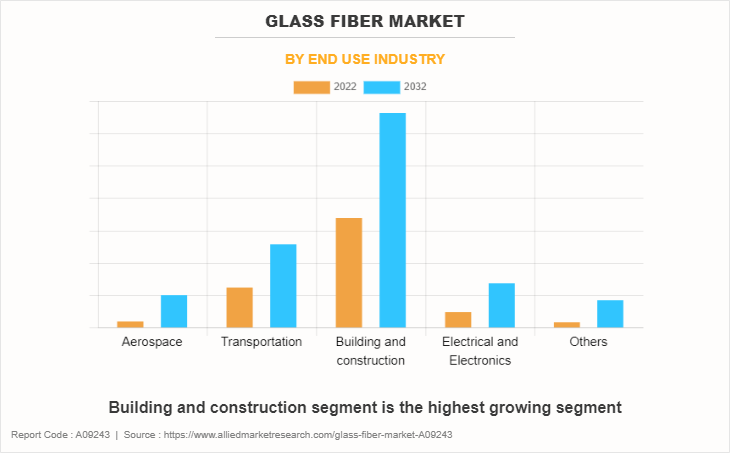
Glass Fiber Market By End Use Industry
In 2022, the building and construction end use industry segment was the largest revenue generator, and is anticipated to grow at a fastest CAGR during the forecast period. Glass fibers are used in architectural elements such as columns, domes, and decorative features. The versatility of glass fibers allows for the creation of intricate and aesthetically pleasing designs. Glass fiber-reinforced materials are used in the construction of bridges for components like such as decks, girders, and railings.
These materials provide high strength and resistance to environmental conditions. Composite materials with glass fiber reinforcements are used in the production of building materials such as doors, window frames, and decking. These materials offer a balance of strength and durability
The leading players in the global glass fiber market are Honeywell International Inc., Nippon Electric Glass Co., Ltd., TAIWAN GLASS IND. CORP., SGL Carbon, Mitsubishi Chemical Group Corporation, Owens Corning, 3B - The Fibreglass Company, Johns Manville, Montex Glass Fibre Industries Pvt. Ltd., and China Jushi Co., Ltd.
The key players have adopted strategies such as product launch to increase their market share. The global glass fiber market report provides in-depth competitive analysis and profiles of these major players.
Key Benefits For Stakeholders
- This report provides a quantitative analysis of the market segments, current trends, estimations, and dynamics of the glass fiber market analysis from 2022 to 2032 to identify the prevailing glass fiber market opportunities.
- The market research is offered along with information related to key drivers, restraints, and opportunities.
- Porter's five forces analysis highlights the potency of buyers and suppliers to enable stakeholders make profit-oriented business decisions and strengthen their supplier-buyer network.
- In-depth analysis of the glass fiber market segmentation assists to determine the prevailing market opportunities.
- Major countries in each region are mapped according to their revenue contribution to the global market.
- Market player positioning facilitates benchmarking and provides a clear understanding of the present position of the market players.
- The report includes the analysis of the regional as well as global glass fiber market trends, key players, market segments, application areas, and market growth strategies.
Glass Fiber Market Report Highlights
| Aspects | Details |
| Market Size By 2032 | USD 34.8 billion |
| Growth Rate | CAGR of 5.3% |
| Forecast period | 2022 - 2032 |
| Report Pages | 400 |
| By End Use Industry |
|
| By Type |
|
| By Application |
|
| By Region |
|
| Key Market Players | Mitsubishi Chemical Group Corporation, Honeywell International Inc., SGL Carbon, China Jushi Co., Ltd., Nippon Electric Glass Co.,Ltd., 3B - the fibreglass company, TAIWAN GLASS IND. CORP., Owens Corning, Montex Glass Fibre Industries Pvt. Ltd., Johns Manville |
Analyst Review
According to CXOs of leading companies, the global glass fiber market is expected to exhibit high growth potential. Glass fiber is a key component in the manufacturing of wind turbine blades. The strength, stiffness, and resistance of material to environmental factors make it suitable for producing large and efficient wind turbine components. Furthermore, glass fiber is used in medical applications, including orthopedic casts and prosthetics. Fiberglass provides strength and flexibility while allowing for customization to suit individual patient needs. The CXOs further added that sustained economic growth and the development of the aerospace sector have surged the popularity of glass fiber.
Glass fiber, also known as fiberglass, is a material made from extremely fine fibers of glass. These fibers can be woven into fabrics or used as a reinforcement in various composites.
The global glass fiber market was valued at $20.9 billion in 2022, and is projected to reach $34.8 billion by 2032, growing at a CAGR of 5.3% from 2023 to 2032.
The glass fiber market is segmented into type, application, and region. On the basis of type, the market is categorized into S glass fiber, C glass fiber, E/ECR glass fiber, and others. On the basis of application, it is segregated into insulation, filtration media, reinforcements, optical fibers, and others. On the basis of end-use industry, it is segregated into aerospace, transportation, building and construction, electrical and electronics, and others. On the basis of region, the market is studied across North America, Europe, Asia-Pacific, and LAMEA
Glass fiber composites are utilized in the production of various sporting goods, such as tennis rackets, golf clubs, and bicycles, to enhance strength and reduce weight.
Asia-Pacific is the largest regional market for glass fiber.
Honeywell International Inc., Honeywell International Inc., Nippon Electric Glass Co., Ltd., TAIWAN GLASS IND. CORP., SGL Carbon, Mitsubishi Chemical Group Corporation, Owens Corning, 3B - The Fibreglass Company, Johns Manville, Montex Glass Fibre Industries Pvt. Ltd., and China Jushi Co., Ltd.
Insulation segment is the leading application of glass fiber market.
Loading Table Of Content...
Loading Research Methodology...


